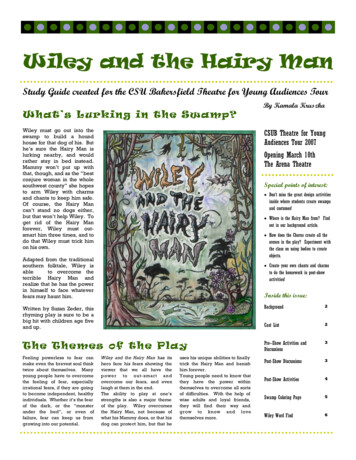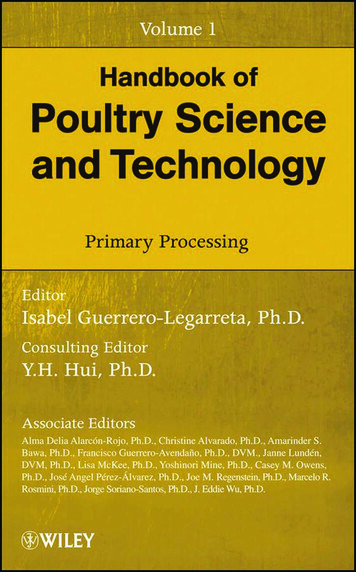
Transcription
Wiley and the Hairy ManStudy Guide created for the CSU Bakersfield Theatre for Young Audiences TourBy Kamala KruszkaWhat’s Lurking in the Swamp?Wiley must go out into theswamp to build a houndhouse for that dog of his. Buthe’s sure the Hairy Man islurking nearby, and wouldrather stay in bed instead.Mammy won’t put up withthat, though, and as the “bestconjure woman in the wholesouthwest county” she hopesto arm Wiley with charmsand chants to keep him safe.Of course, the Hairy Mancan’t stand no dogs either,but that won’t help Wiley. Toget rid of the Hairy Manforever, Wiley must outsmart him three times, and todo that Wiley must trick himon his own.CSUB Theatre for YoungAudiences Tour 2007Opening March 10thThe Arena TheatreSpecial points of interest: Don’t miss the great design activitiesinside where students create swampsand costumes! Where is the Hairy Man from? Findout in our background article.Caption describing picture or graphic.Adapted from the traditionalsouthern folktale, Wiley isableto overcome theterrible Hairy Man andrealize that he has the powerin himself to face whateverfears may haunt him. How does the Chorus create all thescenes in the play? Experiment withthe class on using bodies to createobjects. Create your own chants and charmsto do the housework in post-showactivities!Inside this issue:2BackgroundWritten by Suzan Zeder, thisrhyming play is sure to be abig hit with children age fiveand up.Cast ListThe The mes o f the Pla yPre–Show Activities andDiscussions23Feeling powerless to fear canmake even the bravest soul thinktwice about themselves. Manyyoung people have to overcomethe feeling of fear, especiallyirrational fears, if they are goingto become independent, healthyindividuals. Whether it’s the fearof the dark, or the “monsterunder the bed”, or even offailure, fear can keep us fromgrowing into our potential.Wiley and the Hairy Man has itshero face his fears showing theviewer that we all have thepower to out- smart andovercome our fears, and evenlaugh at them in the end.The ability to play at one’sstrengths is also a major themeof the play. Wiley overcomesthe Hairy Man, not because ofwhat his Mammy does, or that hisdog can protect him, but that heuses his unique abilities to finallytrick the Hairy Man and banishhim forever.Young people need to know thatthey have the power withinthemselves to overcome all sortsof difficulties. With the help ofwise adults and loyal friends,they will find their way andgrow to know and lovethemselves more.3Post-Show Discussions4Post-Show Activities5Swamp Coloring Page6Wiley Word Find
Page 2Wiley and the Hairy ManAbout the Origins of the StoryWiley and the Hairy Man traces itsorigins to the American South.Long held as an oral tradition,during the Federal Writers Projectof the New Deal Era, it was finallycaptured in text form by DonnellVan de Voort.The story wasoriginally set in the AlabamaSwamps, but according toplaywright Suzan Zeder it canhappen, “anywhere there areswamps, and magic, and smallfrightened boys.”In Zeder’s version she has changedthe ending and has “written a playabout a small boy with a big fearwho learns to overcome his ownproblems himself. “ Zeder goes onto state, “I wanted to write a playabout kinds of fears that childrenface, alone in the dark. I wanted towrite a play about magic—goodmagic and bad—and, mostimportantly, the magic that all of ushave somewhere deep inside us.”Published in 1972, Wiley and theHairy Man has been performedextensively throughout the world.Zeder, long considered a majorplaywright for young audiences isalso the author of Step on A Crack,Doors, Mother Hicks, and In a RoomSomewhere.All her plays arecharacterized by their sensitivity tothe particular perspective a childhas within our world, and treatsThe swamp where Wiley livesthem with the artistic respect theydeserve.“Stampin’ stompin; comingThe Castthrough the trees, shuffling’The cast of our show is made up entirely ofstudents at CSUB. Coming from variousmajors and backgrounds, our actors allhave in common the desire to work withyoung audiences. They rehearsed theshow for the Winter Quarter on Tuesdayand Thursday mornings. On tour, they willperform at over ten schools, the BealeLibrary and for the students at CSUB. Theyare definitely a fine, dedicated cast ofactors.WileyJake J. FacileMammyTeresa LandgonDogKatherine CruzHairy ManFabian EurestiSpriteCourtney ShermanSpriteAnita Sandovalthrough the swamp grass,blowing in the breeze, boundingpounding fast as he can. Whatdid Wiley see? He saw theHairy Man!”Director’s Notes:What To Look for in Our ProductionIn 1993, one of my first professionalshows was in a regional tour of Wileyand the Hairy Man, for Childsplay,Arizona’s professional theatre for youngaudiences. Since that tour, I have alwayswanted to mount the show again.What I think is unique to thisproduction is the use of the chorus asenvironmental elements in the show.They become everything . . .stickerbushes, alligators, stumps, and even thespooky sounds that the swamp makes. Itis this use of the actor that I find soengaging for the young viewer. To seean actor transform physically andvocally into whatever they arepretending to be is very much the artthat the child practices on a daily basis.Capturing this environment requireda set designed to appear playful and yetpart of the swamp. Student designerTiffany Pounds has done just that,creating a set that is both aplayground—complete with slide,teeter-totter and rope climb– with therealistic backdrop of the murky swampand the added foliage onstage to createtexture.Costumes, designed by Roger Upton,capture the rural feel with overalls,pinafores and lots of calico. We hopethat our vision of Wiley takes you into theThere may be an alligator or twohidden on the setplayful nature of the play, as well as itsmore suspenseful moments. After all,who doesn’t like to watch a scary movienow and again, if only to shriek and thenlaugh knowing that you and your heroesare all right.Director—Kamala Kruszka
Page 3CSUB Theatre for Young Audiences Tour 2007Discussions for Before the Show In our play, Wiley has to go intothe swamp to build a houndhouse for his dog. Because it is amuddy place, Wiley has to beaware of pricker bushes andquicksand, not to mentionalligators. When we go walkingin our countryside, what animalsand plants do we need to beaware of?Wiley and Mammy use rhymingchants to help them keep safefrom the Hairy Man. In thetheatre actors tell each other to“break a leg” as a way ofwishing good luck before doinga show. Can you think of anysayings people say to each otherthat are meant to extend goodluck. In our play there is a chorus.The chorus is there to act as asort of narrator, setting up thescene and giving the audiencemore details. What other playsor stories do you know that havea narrator? The Hairy Man is a type of“boogey man” or monster. Canyou think of other stories aboutmonsters? How do the heroesovercome the monsters and winin the end? The Hairy Man has hairy feet,hairy eyeballs and spits sparks!What do you think he will looklike in the play?Pre-Show ActivitiesSwamp SettingsIn this guide is a coloring sheet allabout animals that make their homesin wetlands and swamps.Havestudents pretend they are the setdesigner for our play. Have themdraw a backdrop that includes someof these animals. What colors mightseem more “swampy’? What kindsof trees and plants can be includedto create the shadowy wet world ofthe swamp? (TA 2,5)Chorus ConventionIn our production the chorustransforms into scenery. Break theclass into groups of three or four andsee if they can make the followingthings using their bodies:pit of quicksandpricker bushtree stumpsfireplacetables and chairsThis will give students a good ideaof what the chorus will be doing.(TA 2)Poetic ChorusOn page 2 of the guide is a quotefrom the play that introduces theHairy Man (stampin’ stompin’ etc.)Copy this on the board and have theclass break into groups of four.Allow each group to decide uponthe way to dramatize this piece ofdialogue to create the very scaryHairy Man entrance.Encouragestudents to use their bodies andvoices to bring the text to life.(TA 1,2)Discussions for After the Show Why was Wiley so scared of theHairy Man? How did tricking theHairy Man help Wiley to overcome his fears? Are there thingswe are afraid of that we can tryto overcome? What might we dothe next time we are scared?(TA 4)Before you saw the show youmay have had a picture in yourmind of how the Hairy Man would look. How did our HairyMan look? Was he differentfrom what you expected? Whatwould you have changed in hiscostume to make him look morelike your image? (TA 4)The play is written in rhyme soat times the chants and spellscan sound almost like songs.Which spells do you remembermost? (TA 1, 4) Mammy gives Wiley a lot of helpin the play, but mostly encourages him to learn to take care ofhimself. What things do our parents do to help us become moreindependent? What things dothey teach us that help us whenthey are not around? (TA 4)
Page 4Wiley and the Hairy ManActivities for After the ShowWhat Ever Happened To?What happened to Wiley’s pappy?See if the class can come up with anoriginal scenario and dialogueabout the day that Pappydisappeared by Tombigbee River.Preparing the text as a script willgive students the opportunity tobecome playwrights and extend thethemes of the play. (TA 2)Map to the Center of the SwampWiley has to go into the swamp, butthere are places to avoid. See if thegroup can draw a map for Wiley thatshows the way from his house to thetree he must cut down to build dog’shound house. Remember to includethe sticker bushes, quicksand,snakes, bats and alligators. Includea compass so we can tell whichelements are North, South, East andWest. Finally, see if you can includea distance measurement that showshow many feet per inch are shownon the map. (TA 5)Monster PartyNow that you have encountered ourmonster, see if you can create onespecific to Kern County. Wheremight it live? What might it eat?What animals would it be able tochange into?Allow students tobecome their monsters throughvoice and movement. Maybe youcould have a monster party wherethey all meet and get to know eachother. The dramatic possibilities areendless. (TA 2)Monsters from other LandsIn many folktales there aremonsters that are overcome.Ireland and England have storiesabout giants, Germany trolls, andChina has stories about dragons.Mexico has stories about LaLlorona. All monster stories havethe common thread that they areeventually overcome by someoneelse.Have students write anoriginal monster tale based upon acultural monster from a differentland. How is this monster similar tothe Hairy Man and how is itdifferent? (TA 3)Chant-o-ramaPretend you can make up a chantto make the clothes on the floor gointo the closet, or to make yourbed. How might that chant go?Have the group think of a rhymingchant or spell they could use forany household task from washingthe dishes to mowing the lawn.Maybe, “Grass, grass do not grow.Machine over there, start to mow!”(TA 2, 5)Hound Dog HelpersPlaying the hound dog is perhapsthe most fun part in our play.Break the class into pairs andcreate scenes of Wiley playingwith Hound Dog. When is he readyto play, when would he rathersleep? How does this hound barkand chase the Hairy Man? (TA 2)Sources used in this Study GuidePearson-Davis, Susan, ed. Wish in One Hand and Spit in the Other: A collection of plays by Suzan Zeder. NewOrleans: Anchorage Press, 1990.Jennings, Coleman. Theatre for Young Audiences. New York: St. Martins Press, 1998.Van de Voot, Donnell, “Wiley and the Hairy Man.” A Treasury of American Folklore. Ed. B. A. Bodkin. New York:Crown Publishers, 1944.The Young Scientists Introduction to Wetlands, US Army Corps of Engineers, 1999.Complete packet found at http://el.erdc.usace.army.mil/wetlands.ysi.html.
Page 5CSUB Theatre for Young Audiences Tour 2007Wetland AnimalsWetlands serve as nurseries forfishes.Many birds, especiallywaterfowl, build nests and raise theiryoung in wetlands. Migratory birdsdepend on food from the wetlands,that lie on the way of their route, andin the south, many birds winter in thewetlands. Amphibians and reptilesmake wetlands their homes.Salamanders, frogs and toads, turtles,alligators and snakes live inwetlands.Insects and spiders,butterflies and moths, along withmammals from the tiny mouse to theferocious bobcat or gigantic moose—all these creatures are supported bythe different wetlands. Here is a listof the animals shown above: alligator,bobcat, spotted turtle, moose, frog,dragonfly, beaver, muskrat, duck,eagle, sandpiper, bass. Can you findthem?
CSUB Theatre for Young Audiences Tour 2007Page 6
Wiley and the Hairy Man Wiley must go out into the swamp to build a hound house for that dog of his. But . Study Guide created for the CSU Bakersfield Theatre for Young Audiences Tour Opening March 10th . On page 2 of the guide is a quote from the play t










